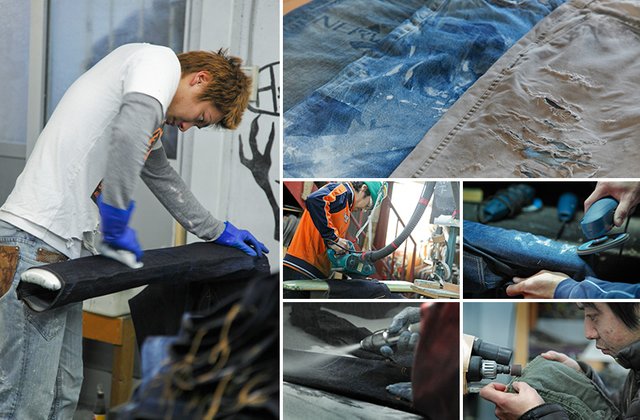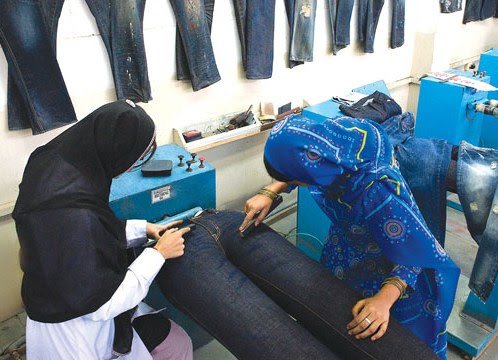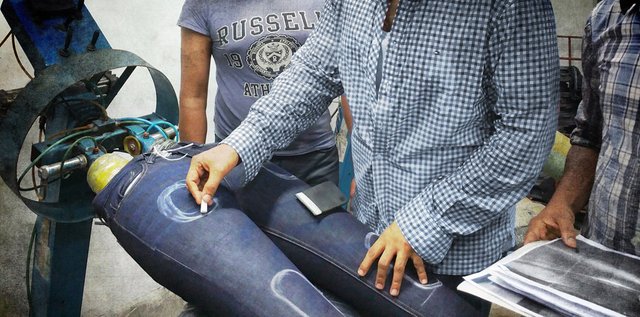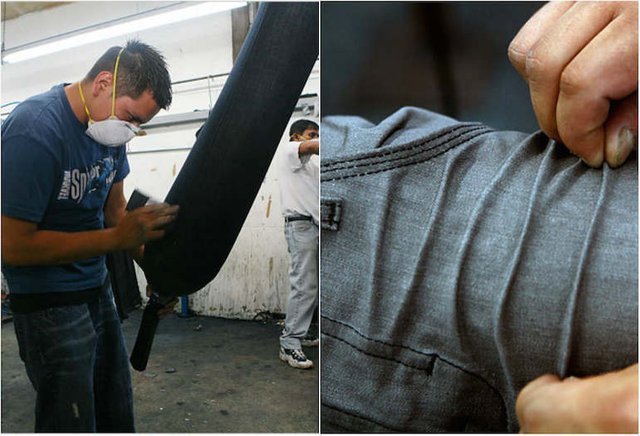Anyruddho Roy
Dept. of Textile Engineering,
Northern University Bangladesh
What is denim?
Denim is a rugged twill textile, in which the weft passes under the two or more warp yarns, producing the familiar diagonal ribbing identifiable on the revere of the fabric.
You may also like: What is Denim | Different Types of Denim
Characteristics of denim fabric:
Warp yarns are colored (usually with indigo, vat, blue or sulphur black ).
Structure : right hand or left hand twill, i.e. z/s-twill of 2/1 or 3/1construction.
Usually made of cotton yarns of coarser count (7s, 10s, 14s, 16s, etc )
Coarser cloth ( weight lies between 6-14 oz/sq.yds ) and used for pant and warm jackets.
Rotor yarn are usually used.
Classification of denim fabric :
- As per weight /unit area:
Light weight : 4.5 to 7 oz/sq.yd
Medium weight : 7 to 10 oz/sq.yd
Heavy weight: 11 and above. - As per hue and color:
Indigo vat.
Sulphur black.
Pigment. - As per slub yarns:
Warp yarns are slub only.
Weft yarn are slub only.
Cross Hatch : both way slub i.e. both warp and weft yarn are slub. - As per fabric structure/design:
Plain.
Twill (S-twill, Z-twill, herringbone or zigzag twill)
Jean: It comes from French word “Genes” used to describe the pants sailors from Genoa, Italy, once wore. While the historical definition implied that all jeans were made of denim , jeans today usually refer to a garments that has five pockets (two in the front, two in the back and small change pocket on the front right pocket) and this style can be made using any kinds of fabrics be it corduroy, twill, or bull denim.
Jeans: Long, narrow pants, especially for women , manufactured by diagonal weave cotton fabric, named after where the texture originally were manufactured, the town Genoa, Italy . Jeans are pants or trousers, made from denim. Mainly designed for work, they became popular among teenagers starting in the 1950. Historic brands include levi’s American population spent more than $14 billion on jeans in 2004.
Bull Denim: Piece-dyed cotton twill made from coarse yarn to resemble denim, however , the warp yarns are not dyed with indigo before weaving.
Bell Bottom: A jeans style born in the late 60s, 70s. Bell-bottom are trousers that become wider from the knees downward. Tight at the waist (some times lowered ) and at the thighs , the trousers flare out from the knee to make a come back at the end of the 80s, but didn’t quite catch on.
Cross Hatch: An effect of the denim weave created by using uneven yarn in the weft direction, combined with uneven yarns in the warp direction.
Hipster jeans: A style of jeans that start about 10 centimeters below the navel.
Rigid Denim: Describe unwashed denim. Most denim garments are typically prewashed before going to retail.
Low rise Jeans: Low rise Jeans worn by both men and women, are jeans intended to sit low on or below, the hips. They are also called low cut jeans , hipsters, hip-huggers and lowriders . Usually they sit at least 8cm (3”) lower than belly button.
Denim Wash:
Now-a-days denim wash is much popular both dry and wet washing process. According to the fashion and appearance, there include new washing process and technology such as 3D or laser techniques. In denim washing is done to produce effects like color fading with or without patchiness, crinkles, seam puckering, hairiness, Pilling softened-hand feel, stabilized dimension etc. Most of the denim wash effect vintage look. Now I want to describe briefly denim washing types with flow chart.
Process Flowchart of Denim Washing:
Garment Received from Finishing
↓
Garments Dry
↓
Garments wet process
↓
loading garments for washing
↓
De size garment
↓
Enzyme wash
↓
Extracting for extract water removing
↓
Garments Drying
↓
Potassium Permanganate Spray
↓
Softener
↓
Extracting
↓
Drying
↓
Washing Quality Control
↓
Next Process
You may also like: Process Flow Chart of Denim Manufacturing

Types of denim wash:
Denim washes are of following two type :–
- Chemical washes:
Denim bleaching
Enzyme wash
Acid wash - Mechanical washes:
Stone wash
Microsanding
Denim Bleaching:
In the process a strong oxidative bleaching agent like sodium hypochlorite or KMnO4 is added during the washing with or without stone addition. Discoloration produced is usually more apparent depending on strength on the bleach liquor quality, temperature and treatment time. It is preferable to have strong bleach with short treatment time.
Care should be taken for the bleached goods so that they should be adequately antichlored or after washed with peroxide to minimize yellowing. Materials should be carefully stored before processing for color uniformity,
Process cycle:
Step # 1(Desizing)
Load the garments into the washing machine (100 kg) ;
Add water (liquor ratio 1:5) and start the machine running(12-15 rpm) ;
Add amylase enzyme (1 to 3% i.e.1 to 3 kg) ;
Add detergent (1% i.e. 1kg) ;
Supply steam to raise temp.(60°C) ;
Continue the process for 20 min and then drain the liquor ;
Hot wash (at temp. of 40°C to 50°C for 5 minutes).
Step # 2 (Bleaching)
Add Water into the m/c (1:5 liquor ratio, i.e. 500 litres );
Start m/c running ( 12 to 15 rpm ) and add soda ash (Na2CO3) to liquor (2% i.e. 2kg) ;
Add costic soda (NaOH) to liquor (2% i.e. 2kg) ;
Add bleaching chemical (H2O2) to liquor (5ml per liter, i.e. 2.5 liters) ;
Add stabilizer to liquor (2ml per liter, i.e. 1 liter) ;
Supply steam to raise temp.(70°-800C) ;
Continue the process for 60 to 70 min. and drain the liquor ;
Hot wash (at 60°C for 5 minutes).
Step # 3 ( Nutralization)
Add Water into the m/c (1:5 liquor ratio, i.e. 500 liters );
Start m/c running ( 12 to 15 rpm );
Add acetic acid ( CH3COOH ) to liquor (1 to 2 ml per liter, i.e. 500ml to 1liter);
Continue the process for 10-15 min and then drain the liquor.
Step # 4 ( Brightening treatment)
Add Water into the m/c (1:5 liquor ratio, i.e. 500 litres );
Add Fluorescent Whitening agent/Fluorescent Brightening agent to liquor (% as required );
Supply steam to raise temperature (800C);
Continue the process for 10 min and then drain the liquor.

Step # 5 (Softening)
Add Water into the m/c (1:5 liquor ratio, i.e. 500 litres );
Start m/c running ( 12 to 15 rpm );
Add softener to the liquor (0.1 to 0.5%, i.e. 100g to 500g);
Supply steam to raise the temperature (as required 400 to 600C );
Continue the process for 5 minutes and then drain the liquor and unload the garments.
Limitations of denim bleaching :
Process is difficult to control i.e. difficult to reach the same level of bleaching in repeated runs.
When desired level bleaching reached the time span available to stop the bleaching is very narrow. Due to harshness of chemical, it may cause damage to cellulose resulting in severe strength losses and or breaks or pinholes at the seam, pocket, etc.
Harmful to human health and causes corrosion to stainless steal.
Required antichlor treatment.
Problem of yellowing is very frequent due to residual chlorine.
Chlorinated organic substances occur as abundant products in bleaching and pass into the effluent where they cause severe environmental pollution.
Enzyme Wash:
It is environmentally friendly wash. It involves the application of organic enzymes that eat away at the fabric, i.e. the cellulose. When the desired color is achieved, the enzyme can be stopped by changing the alkalinity of the bath or its temperature. Post treatment includes final ringing and softening cycle. The effects produced by cellulose enzyme are :—-
Use of cellulose making the seams, hems, and pockets more noticeable;
Salt paper effect is color contrast effect.
Faded garment washed with acid cellulose enzyme provides less color contrast in proportion to garment washed neutral cellulose enzymes.
Garment load size of the m/c is 35-40 jeans per m/c and it cannot be overloaded.
Acid Wash:
It is done by tumbling the garments with pumice stones presoaked in a solution of sodium hypochlorite or potassium permanganate for localized bleaching resulting in a non uniform sharp blue/white contrast. In this wash the color contrast of the denim fabric can be enhanced by optical brightening. The advantage of this process is that it saves water as addition of water is not required.
It consists of soaking pumice stones with chlorine and using their abrasive power to bleach jeans into sharp contrasts. Also known as moon, fog, marble, ice and frosted.
Process cycle :
Step # 1(Desizing)
Load the garments into the washing machine (100 kg) ;
Add water into the machine(1:5 liquor ratio i;e. 500 liters) ;
Start machine running (12 to 15 rpm) ;
Add amylase enzyme (1 to 3% i.e.1 to 3 kg) ;
Add detergent (1% i.e. 1kg) ;
Supply steam to raise temp.(60°C) ;
Continue the process for 20 min and then drain the liquor ;
Hot wash at temp. of 40°C to 50°C for 5 minutes.
Step # 2 ( Bleaching)
To carry out the Bleaching process, the following two steps are to be passed over :
Step # A
Take stone of some volume of the volume of garments ;
Soak the sfone with the following chemical solution for 2 to 3 minutes ;
Water 100 litres
Potassium permanganate 1 kg
Phosphoric acid 300 ml (3ml per litres)
Here the porous of stones are dried in the open air for 60 to 90 min.
Step # B
Load the garments treated in step # 1 and step # 2 in a dry m/c. Lot size should be 20 to 30kg.
Run the m/c for 5 to 7 minutes. Due to the rotation of m/c the socked stones will hit the garments surfaces and the chemicals in the stone will destroy color of the fabric. Multilayer fabric areas like collar, cuff, pocket, pocket side seam etc. area will be brushed more than the single layer areas, therefore more fading effect will be produced in those areas resulting new color effect in the garments.
Unload the garments and separate the stones from the batch.
In this stage KMnO4 and H3PO4 reacts with each other and gives Oxygen which oxidize the color.
Here a byproduct MnO2 is produced which should be neutralized.
6KMnO4 + 4H3PO4 = 2K3PO4 + Mn3(PO4)2 + 6H2O + 3MnO2 + 2O2
This MnO2 is solubilized by Sodium Metabisulfite (Na2S2O5).
Na2S2O5 + H2O = 2NaHSO3
NaHSO3 + MnO2 = MnSO4 + NaOH
Load the garments to the m/c ;
Add water into the m/c (1:5 liquor ratio, i.e. 500 litres) ;
Continue the process (12 to 15 rpm) ;
Add sodium metabisulfite (1 to 2 gpl, i.e. 500 g to 1kg) ;
Continue the process for 5 to 10 min and then drain the liquor ;
Hot wash (at 40o to 50o C for 5 minutes).
Step # 3 ( Nutralization)
Add Water into the m/c (1:5 liquor ratio, i.e. 500 litres );
Start m/c running ( 12 to 15 rpm );
Add acetic acid ( CH3COOH ) to liquor (1 to 2 ml per liter, i.e. 500ml to 1liter);
Continue the process for 10-12 min and then drain the liquor.
Step # 4 ( Brightening treatment)
Add Water into the m/c (1:5 liquor ratio, i.e. 500 litres );
Add Fluorescent Whitening agent/Fluorescent Brighting agent to liquor (% as required );
Supply steam to raise temperature (800C);
Continue the process for 10 min and then drain the liquor.
Step # 5 (Softening)
Add Water into the m/c (1:5 liquor ratio, i.e. 500 litres );
Start m/c running ( 12 to 15 rpm );
Add softener to the liquor (0.1 to 0.5%, i.e. 100g to 500g);
Supply steam to raise the temperature (as required 400 to 600C );
Continue the process (5 minutes) ;
Drain the liquor and unload the garments.
Limitations of acid wash :
Acid washed ,indigo dyed denim has a tendency to yellow after wet processing.
The major cause is residual manganese due to incomplete neutralization, washing or rinsing.
Remedy :
Manganese is effectively removed during laundering with addition of ethylene-diamine-tetraacetic acid as chelating agent.
Acid washing jeans avoided some of problems of stone wash, but come with added danger, expenses and pollution.
Stone Wash:
In the process of stone washing, freshly dyed jeans are loaded into large washing machines and tumbled with pumice stone or volcanic rock to achieve a soft hand and desirable look. Variations in compositions, hardness, size shape and porosity make these stone multifunctional. The process is quite expensive and requires high capital investment. Pumice stone give the additional effect of a faded or worn look as it abrades the surface of the jeans like sandpaper, removing some dye particles from the surfaces of the yarn.
Step # 1(Desizing)
Load the garments into the washing machine (100 kg) ;
Add water into the machine(1:5 liquor ratio i;e. 500 liters) ;
Start machine running (12 to 15 rpm) ;
Add amylase enzyme (1 to 3% i.e.1 to 3 kg) ;
Add detergent (1% i.e. 1kg) ;
Supply steam to raise temp.(60°C) ;
Continue the process for 20 min and then drain the liquor ;
Hot wash (at temp. of 40°C to 50°C for 5 minutes).
Step # 2 (Stone wash)
Add Water into the m/c (1:5 liquor ratio, i.e. 500 litres );
Add pumice stone half of the volume of garments (30 to 15 kg) ;
Start machine running (12 to 15 rpm) ;
Add bleaching powder to liquor (4% i.e. 4kg) ;
Add soda ash (Na2CO3) to liquor (8% i.e. 8kg) ;
Continue the process for 20 min to 40 min and then drain the liquor ;
Hot wash (at 40°C to 50°C for 5 minutes).
Step # 3(Softening)
Add water into the machine(1:5 liquor ratio, i,e. 500 liters).
Start machine running (12 to 15 rpm).
Add softener to the liquor (0.1 to 0.5%, i,e. 100 g to 500 g).
Supply steam to raise the temp. (as required 40° to 60°C).
Continue the process (5 min).
Drain the liquor and unload the garments .
Selection of stone:
Stone should be selected of the proper hardness , shape and size for the particular end product. It should be noted that large , hard stones last longer and may be suited for heavy weight fabrics only. Smaller, softer stones would be used for light weight fabrics and more delicate items. Stone wt. / fabric wt. = 0.5 to 3 it depends on the degree of abrasion needed to achieve the desired result. Stones can be reused until they completely disintegrate or wash down the drain.
Problem caused by stones:
Damage to wash machineries and garment due to stone to machine and machine to stone abrasion.
Increase in labor to remove dust form finished garments .
Water pollution during disposal of used liquor.
Back staining and re-deposition.
Back staining or Re-deposition: The dye removed from denim material after the treatment with cellulose or by a conventional washing process may cause “back staining “ or “re-deposition”. Re-coloration of blue threads and blue coloration of white threads, resulting in less contrast between blue and white threads.
Remedy of back staining:
Adding dispersion/suspension agent to wash cycle. ¤Intermediate replacement of wash liquor. ¤Using alkaline detergent like sodium per borate with optical brightener as after wash.
Limitation of stone washing:
Quality of the abrasion process is difficult to control outcome of a load of jeans is never uniform, little percentage always getting ruined by too much abrasion.
The process is non selective.
Metal buttons and rivets on the jeans in the washing machines get abraded .
This reduces quality of the products and life of equipment, and increases production costs.
Stones may turn into powder during the process of making the garment grayish in color and rough too.
Provides rougher feel than enzyme wash.
Stone may lead the harm to machine parts.
Microsanding:
A fabric finishing process where fabrics are sanded (real sandpaper) to make the surface soft without hair. Can be performed before or after dyeing. In this fabric treatment process, a series of cylindrical rolls in a horizontal arrangement, either wrapped with an abrasive paper or chemically coated with an abrasive are used to create a soft, sueded hand. The denim is pulled over the face of the sand rollers creating a raised surface finishing. Some color reduction is experienced.
There are 3 ways for this technique:
Sandblasting.
Machine sanding.
Hand sanding or hand brushing.
Used in various ways:
Flat surfaces (tables, ironing boards).
On the dummy (inflatable dummies, sometimes standing, sometimes flat, sometimes seated).
Various templates can be used to create a 3D effect.
Sand blasting:
Jeans wear treatment that removes color from certain areas, either all over or placed and gives the garment additional softness. Sand is actually shot at the garment with a powerful spray gun. Recent technology has introduced “automatic” sandblasting, in which the jeans hang and rotate continuously.
It is purely mechanical process, not using in chemicals.
It is a water free process therefore no drying required.
Variety of distressed or abraded looks possible.
Any number of designs could be created by special techniques.
It is a process applied on denim fabric garments to get heavy faddy effects on particular points.
Sand blasting technique is based on blasting an abrasive material in granular, powdered or other form through a nozzle at very high speed and pressure onto specific areas of garment surface to be treated to give the desired distressed/abraded/ used look.
You may also like: Different Types of Dry Process for Denim Wash
Process:
Individual garment to be processed is taken on a table.
Air compressor is started and pressure to maintained between 3-4 kg/sq.cm. Air compressor then stores air in the machine cylinder.
Aluminum sand or silicon sand, Al2(SiO4)3, is than taken in the chamber of the blasting machine.
Sand and compressed air is than sprayed over the garments at specific points by hand spray pipe.
Sand pass into the machine by regulating system. The machine comprises a blasting regulator and a hand regulator to control the amount of sand and compressed air respectively.
Conclusion:
Finally, in denim washing our country has a bright future due to wide spread market of denim garments. We need thorough knowledge on denim treatment process and also on the fashion going around the world. And this project will be a guideline for them who are interested in the sector. pioneer in the field of hard washing. And we believe that this project will be a guideline for the washing plants in understanding and doing various treatments.
Congratulations @anyruddho! You have completed the following achievement on Steemit and have been rewarded with new badge(s) :
Click on the badge to view your Board of Honor.
If you no longer want to receive notifications, reply to this comment with the word
STOPDo not miss the last post from @steemitboard:
SteemitBoard World Cup Contest - Semi Finals - Day 1
Participate in the SteemitBoard World Cup Contest!
Collect World Cup badges and win free SBD
Support the Gold Sponsors of the contest: @good-karma and @lukestokes
Downvoting a post can decrease pending rewards and make it less visible. Common reasons:
Submit